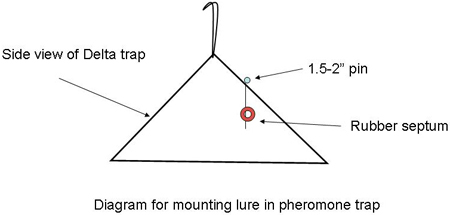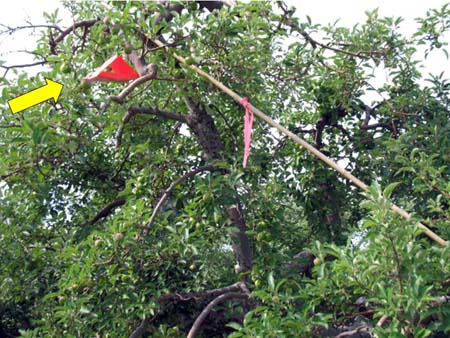How to optimize placement of pheromone traps in your orchard
Pheromone traps are useful tools to monitor codling moths and Oriental fruit moths in orchards
Pheromone traps are an important IPM tool to track moth catches and evaluate pest pressure. Well-placed and maintained traps can greatly improve decision making when it comes to timing insecticide applications, and determining the need for insecticide applications to control codling moth (CM) and oriental fruit moth (OFM). Keep in mind however, that the traps are not a substitute for visual inspection of fruit to look for signs of infestation. Rather, trapping should be used in conjunction with inspecting fruit for injury.
MSU Extension’s Pocket Guide for IPM Scouting in Michigan Apples (E-2720 – purchase or view on-line) has information about scouting for both CM and OFM in apples. The Pocket Guide for IPM Scouting in Stone Fruits (E-2840 – purchase or view on-line) has detailed information about scouting for OFM in peaches.
There are several types of traps that can be used for monitoring CM and OFM including wing, diamond and delta traps. The plastic delta trap, discussed here, is probably the best option because it is reusable through several seasons, has a large trapping surface, and a removable sticky insert that is easy to replace when the adhesive surface becomes too dirty to catch moths. Traps are available in orange or white. The orange traps are less likely to attract and trap pollinators and other beneficial insects. If you decide to keep the traps to use for additional seasons, remove the spent lures, store traps that have been used for a particular pest species together and be sure that you reuse them for that same species the next year to avoid cross-contamination.
Never place more than one kind of lure in a trap, and avoid re-using the trap with a lure for another species. The pheromones penetrate the trap material, and using a different lure will cause failure of the lure.
 One of the most common lures is a red rubber septum, which resembles a pencil tip eraser. The septum is pre-loaded with pheromone. After assembling the trap, an ingenious way of mounting the lure is to stick a 1.5 to 2 inch plastic- headed sewing pin straight down through one of the top sides, equal distance from both ends. Wearing disposable gloves, pick up the septum, reach inside the trap and stick the pin through the septum widthwise so it hangs horizontally above the bottom of the trap. Then mount all the lures of a single type, change gloves, and switch to the next lure you will need. Wear disposable gloves when handling the lures, and change gloves before you switch to mounting lures for a different species to avoid cross contamination. The sticky bottom can them be slid into the trap, and the side snapped into place.
One of the most common lures is a red rubber septum, which resembles a pencil tip eraser. The septum is pre-loaded with pheromone. After assembling the trap, an ingenious way of mounting the lure is to stick a 1.5 to 2 inch plastic- headed sewing pin straight down through one of the top sides, equal distance from both ends. Wearing disposable gloves, pick up the septum, reach inside the trap and stick the pin through the septum widthwise so it hangs horizontally above the bottom of the trap. Then mount all the lures of a single type, change gloves, and switch to the next lure you will need. Wear disposable gloves when handling the lures, and change gloves before you switch to mounting lures for a different species to avoid cross contamination. The sticky bottom can them be slid into the trap, and the side snapped into place.
OFM traps can be placed at a comfortable height for visual inspection. Avoid using outside tree rows for pheromone traps. Place OFM traps 3 to 4 rows in, at least 25 feet apart and at a density of 1 trap per ten acres.
Remove moths, other insects and debris from the trap each time you check it. Trap bottoms should be changed when they are dirty. Follow manufacturer’s directions for changing lures, but in general for OFM, change lures each generation. Used lures and lure packaging should be removed form the orchard, not dropped on the ground. Keep trap entrances clear of foliage. Hang bright, colored flagging tape (fluorescent pink works well) on the trees where the traps are located, on the end of the row and make a written reference or map for yourself so you can find the traps again as the season progresses.

Coding moth trap placement.
Traps for CM should be hung in the upper third of the tree canopy, on the periphery of the tree with the trap entrances oriented so moths can fly through. A bamboo pole or PVC pole can be used to position the trap high in the canopy. The length of pole needed will depend on the tree height and how high you can comfortably reach. For small to medium-sized trees a 5-6 foot pole should be long enough, but 8-foot or longer poles may be needed for taller trees. Drill a hole near the end of the pole to use for securing the trap. Compress the end of the trap’s wire hanger with a sturdy pair of pliers to enable it to slide through the hole in the bamboo pole, and then wrap the wire back around itself to secure the trap. Traps for CM are now ready to hang.
Find a branch high in the canopy to slip the trap over, and adjust it with the pole so that the trap hangs straight down. Once the trap is in place, hang bright, colored flagging tape (fluorescent pink works well) on the trees where the traps are located, and on the end of the row. Make a written reference or map for yourself in case the tapes get pruned off so you can find the traps again as the season progresses. Keep the trap entrances free of foliage so that moths can follow the odor plume and be lured into the trap. Leaves can be periodically pruned away as the foliage grows.
Traps for CM should be placed at a density of 1 trap/2.5 acres. Place CM traps 3 to 4 rows in and at least 25 feet apart. Remove moths, other insects and debris from the trap each time you check it. Trap bottoms should be changed when they are dirty. When lures are changed, remove both the old lures and the packaging for the new lures from the orchard. Follow manufacturer’s recommendations for frequency of changing lures.
There are several lures available that will last for different lengths of time. Some work better in pheromone disrupted orchards than others. High load lures, containing more pheromone, will need to be changed less frequently than standard lures. For codling moth, a combination lure has been developed that contains both pheromones and an ester present in the odor of ripe Bartlett pears. Called the CM/DA lure, it attracts both male and female CM, and has been found by MSU researchers to be useful in monitoring CM in orchards that have been treated with a mating disruption product. Either pheromone based CM lures or CM/DA lures can be used in non- mating disrupted blocks.
References
- A Pocket Guide for IPM Scouting in Michigan Apples, D. Epstein and L. Gut, MSU Extension Bulletin, E-2720
- A Pocket Guide for IPM Scouting in Stone Fruits, D. Epstein, L. Gut, A. Jones, and K. Maxon-Stein MSU Extension Bulletin, E-2840
- Using pheromone traps to monitor moth activity in orchards. ipmnews.msu.edu/fruit May 19, 2009. Larry Gut, David Epstein and Peter McGhee



 Print
Print Email
Email
